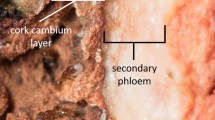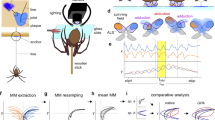Summary
Dendromyrmex chartifex andD. fabricii are weaver ants: the mature larvae of these formicine species add silk to the arboreal carton nests. This material strengthens the layers of vegetable fibers, which form the bulk of the nests and are contributed by the workers. The communal silk spinning is the most primitive yet discovered and may represent the first stage in the evolution of weaving. The larvae, rather than the workers that hold them in their mandibles, make the lateral weaving movements, and their behavior differs from conventional cocoon spinning only in the orientation of the movements relative to the body. Moreover, larvae often contribute silk in this manner even when unattended by workers. Both male and worker-destined larvae spin communally; whether they contribute equal quantities per capita remains to be determined.
Other information on the natural history ofDendromyrmex based on field and laboratory studies is reported: the colonies are polydomous; the workers forage nocturnally and accept a wide variety of insect prey. The workers ofD. chartifex have unusual genal eyespots and behave in such a way as to resemble polybiine wasps, and it is suggested that they are in fact Batesian mimics of these stinging insects.
Zusammenfassung
Dendromyrmex chartifex undD. fabricii sind Weberameisen: Die erwachsenen Larven dieser Formicinen-Arten fügen den arborealen Kartonnestern Seide zu. Dieses Seidematerial verstärkt die aus pflanzlichen Teilchen bestehenden Wände der Nestkammern, die von Arbeitern gebaut werden. Das kommunale Seide-Spinnen vonDendromyrmex ist die bis jetzt primitivste Form dieses Verhaltens und könnte die erste Stufe in der Evolution des Webens bei Ameisen darstellen. Nicht die Arbeiter, welche die Larven mit den mandibeln halten, sondern die Larven machen die seitlich gerichteten Spinnbewegungen. Dieses Verhalten unterscheidet sich vom konventionellen Kokon-Spinnen nur in der Orientierung der Bewegungen in Bezug zum Körper. Oft produzieren sogar die Larven Seide zum Nestbau, ohne dabei von den Arbeitern gehalten zu werden. Männchenlarven und Arbeiterlarven zeigen kommunales Spinnverhalten; ob beide die gleiche Menge Seide per Individuum produzieren muss noch festgestellt werden.
Weitere Beobachtungen im Freiland und Laboratorium zur Biologie vonDendromyrmex werden berichtet: Die Kolonien sind polydom; die Arbeiter furagieren nachts und nehmen eine Vielfalt von Insekten als Futterbeute an. Die Arbeiter vonD. chartifex haben auffallende Augenflecken und verhalten sich als ob sie Polybiinen-Wespen nachahmten. Es wird vermutet, dass es sich hier um eine Batessche Mimikry dieser stechenden Insekten handelt.
Similar content being viewed by others
References
Baroni Urbani C., 1978. — Materiali per una revisione deiLeptothorax neotropicali appartementi al sottogenereMacromischa Roger, n. comb. (Hymenoptera:Formicidœ).Entomol. Basil., 3, 395–618.
Emery C., 1925. — Hymenoptera. Fam. Formicidæ. Subfam. Formicinæ.Genera Insectorum, Fasc. 183, 302 pp.
Forel A., 1905. — Einige biologische Beobachtungen des Herrn Professor Dr. E. Göldi an brasilianischen Ameisen.Biol. Centralbl., 25, 170–181.
Hamilton, W.D., 1964. — The genetical evolution of social behaviour, I, II.J. Theoret. Biol., 7 (1), 1–52.
Hölldobler B., Wilson E.O., 1977. — Weaver ants.Sci. Am., 237 (6), 146–154.
Hölldobler B., Wilson E.O., 1978. — The multiple recruitment systems of the African weaver antŒcophylla longinoda (Latreille) (Hymenoptera: Formicidæ).Behav. Ecol. Sociobiol., 3, 19–60.
Karawajew W., 1929. — Die Spinndrüsen der Weberameisen (Hym. Formicid.).Zool. Anz. (Wasmann-Festband),82, 247–256.
Ofer J., 1970. —Polyrhachis simplex, the weaver ant of Israel.Ins. Soc., 17, 49–82.
Oster G.F., Wilson E.O., 1978. — Caste and Ecology in the Social Insects. Princeton Univ. Press, Princeton, New Jersey. xvi + 352 p.
Trivers R.L., Hare Hope, 1976. — Haplodiploidy and the evolution of the social insects.Science, 191, 249–263.
Weber N.A., 1944. — The tree ants (Dendromyrmex) of South and Central America.Ecology, 25, 117–120.
Wilson E.O., 1962. — Behavior ofDaceton armigerum (Latreille), with a classification of self-grooming movements in ants.Bull. Mus. Comp. Zool., Harvard,127, 403–422.
Wilson E.O., Hölldobler B., 1980. — Sex differences in cooperative silk-spinning by weaver ant larvae.Proc. Nat. Sci., U.S.A., 11 2343–2347.
Author information
Authors and Affiliations
Rights and permissions
About this article
Cite this article
Wilson, E.O. Communal silk-spinning by larvae ofDendromyrmex tree-ants (Hymenoptera: Formicidae). Ins. Soc 28, 182–190 (1981). https://doi.org/10.1007/BF02223704
Received:
Accepted:
Issue Date:
DOI: https://doi.org/10.1007/BF02223704




